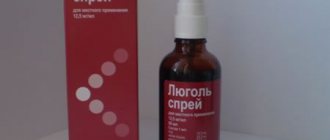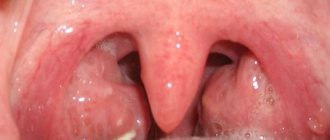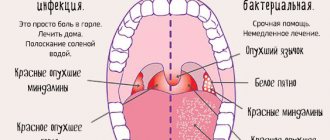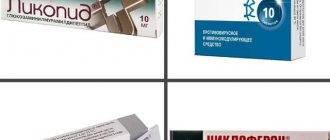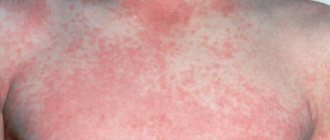What to do if a child has spots in his throat?
Many oral diseases can be accompanied by a symptom such as a rash or spots in the throat. Spots can appear in the pharynx, larynx, tongue, upper palate, or cover the entire oral cavity.
They can be of different colors, shapes and sizes. Noticing red spots in a child’s throat, any parent will be worried and interested in quickly identifying the cause of such a symptom. In this article we will look at the main ones.
The main reasons for the appearance of spots in the throat
Red spots on a child’s throat can be a manifestation of various diseases, but there are several most common causes of this symptom:
viral infection; bacterial infection; allergic reaction.
Each of these ailments has its own characteristic features, so you can try to recognize them yourself. Only an experienced doctor can accurately determine the cause of a rash or spots in the throat by conducting a thorough examination of the child’s oral mucosa.
Viral infection
With acute respiratory viral infections, the appearance of red spots or a rash on the throat is a fairly common occurrence. The spots or rash in such cases are small and fill the upper palate, the back of the pharynx and the uvula.
In addition to rashes, the following symptoms of the disease are noted:
fever up to 38.5-39 ˚C; weakness; nasal congestion and sneezing; swollen lymph nodes; dry cough.
Spots in the throat with ARVI do not require any special treatment, because they go away on their own with standard comprehensive treatment of the disease: rest, plenty of warm drinks, gargling and taking antitussives.
Flu in children is accompanied by redness of the soft palate, tonsils and uvula.
A bright red throat with granular rashes on the roof of the mouth is characteristic of the flu. Such signs usually appear already on the second day of the disease, along with other symptoms of the disease: body aches, sore throat, chills and weakness.
Treatment for influenza is similar to the treatment of other acute respiratory viral infections, but it must include powerful antiviral drugs, for example Rimantadine or Tamiflu, because Influenza develops much faster, is much more severely tolerated and has a more difficult and longer recovery period.
A small red rash in the throat is a sign of herpes sore throat.
Herpes sore throat and stomatitis are also viral in origin. In a child, a red rash in the throat with these diseases looks like small reddish blisters, as in the photo (about 1 mm for sore throat and about 4 mm for stomatitis).
An experienced specialist, looking at such a rash, will instantly make an accurate diagnosis without any additional examinations. To treat rashes, it is imperative to use antiviral agents, for example, Acyclovir.
Bacterial infection
A rash and red throat in a child may be symptoms of the following common bacterial diseases:
Acute tonsillitis, or simply sore throat, begins with a sharp sore throat and high body temperature (up to 40 ˚C). In this case, a red throat with white spots on the tonsils in a child may indicate follicular tonsillitis. If a child has a red spot in the throat that is located mainly on the back wall of the throat, and there is fever, sore throat and cough, then most likely this is a manifestation of pharyngitis. Scarlet fever appears as a pinpoint rash not only in the throat, but also throughout the body. Accompanied by high fever, swelling of the tonsils and signs of general intoxication of the body.
A typical picture of a child's throat with scarlet fever.
Sore throat, scarlet fever and pharyngitis are most often caused by streptococcal infections, so treatment of these diseases is based on antibiotic therapy. To eliminate red spots and rashes that provoke a sore throat in these diseases, it is imperative to use antiseptics in the form of gargling solutions and sprays.
Allergy
A red and white rash in a child's throat may be a manifestation of an allergic reaction to certain foods or medications. An allergy in the throat usually manifests itself externally only as a rash and swelling, so it is quite easy to recognize.
To get rid of the rash, it will be enough to limit all contacts with possible allergens and take antihistamines, for example, Fenistil or Suprastin.
Advice. In order to identify the source of the allergy, you can take a blood test for allergy tests. The price of such a study is quite affordable, and an accurate result will allow you to quickly eliminate the cause of an allergic reaction in a child.
Causes of red spots on the palate in children
A red rash in the mouth is a sign of an allergy
Allergies are caused not only by food or drinks, but also by toothpaste, mouthwash, and recently installed fillings or braces. You can distinguish an allergic reaction from an infection by the following signs:
- The location of the spots is symmetrical
- Sometimes the red dots merge with each other
- The sky around the spots remains light in color
- The rash on the palate does not itch, there is no burning sensation
- Additionally, skin rashes appear
If the red dots are the result of an allergic reaction of the body, then there are no signs of an infectious disease - fever, pain in the throat when swallowing and in the head, runny nose, cough, and mood changes do not appear.
Red dots on the sky are a sign of an infectious disease
Fungal infection
Viral and colds of the respiratory tract
Treatment is prescribed by a doctor and is aimed at relieving the symptoms of the disease and eliminating intoxication.
Herpes sore throat
Treatment is carried out with medications against herpes infection, the temperature is reduced, and a gentle diet is prescribed. Food that can damage the inflamed mucous membranes - sour, spicy, hot, coarse foods - is excluded from children's diet.
Rash in the mouth due to stomatitis
Treatment includes taking antiherpetic drugs, a gentle diet, and lowering the temperature.
Measles and red rash on the palate
Treatment is carried out at home, following all the pediatrician’s instructions.
Erythema infectiosum
Treatment is carried out at home. Antiseptic, antipyretic, and analgesic drugs are used.
Infectious mononucleosis
With this disease, red dots are located on the throat, which also turns red. Additionally, itching occurs, the tonsils become enlarged, and breathing becomes difficult.
Treatment consists of antiseptic treatment of the oral cavity, taking vitamins, and antihistamines.
Based on the results of the examination, antibiotics are prescribed for bacterial infections, antihistamines for allergies, and antiviral agents if viruses are the causative agents. Self-medication is unacceptable - the wrong medicine will only worsen the course of the disease.
- Pasty stool in a child: causes and methods of treatment
- Causes and methods of treatment of herpes pharyngitis in children
- Causes of acute pharyngitis in children and methods of treatment
- Vilprafen for the treatment of children: instructions for using the antibiotic
- "Flemoxin Solutab" - instructions for use for children
- Use of Miramistin for irrigation and inhalation for sore throat in children
What other reasons could there be for a rash in the throat?
In a child, red spots in the throat may appear for other, less common reasons. Sometimes it is quite difficult to determine what caused the appearance of such a symptom.
This is especially true for children in the first year of life, who, in the process of exploring the world around them, constantly taste, sometimes completely unintended objects and substances.
From contact with contaminated surfaces, a child can become infected with fungal diseases, which can also manifest themselves in the form of a rash or spots in the throat, for example:
candidiasis (or thrush); Tonsillomycosis (fungal tonsillitis).
Candidiasis appears as a cheesy white coating.
Both diseases can be caused by the same pathogen - a fungus of the genus Candida, so the external picture of the disease appears approximately the same. A white coating begins to appear on the oral mucosa, and if measures are not taken in time, the fungus spreads throughout the entire pharynx, filling the back wall of the pharynx, tonsils and the root of the tongue with white spots. You can learn more about the manifestations of stomatitis in the video in this article.
When treating fungal diseases of the oral cavity, topical treatments for spots and rashes are necessarily used to stop the growth of the fungus. Cholisal gel has a good effect in the fight against fungi of the genus Candida. The instructions for this drug indicate that it helps with many diseases of the oral mucosa.
Attention. In addition to antifungal therapy, it is imperative to take measures to strengthen the immune system and normalize metabolism, because Fungal diseases always indicate a malfunction of the immune system.
If a child of the first year of life has red spots in the throat and the baby behaves restlessly, you should immediately seek medical help, because the child could have swallowed dangerous substances that burned the oral mucosa, and this could lead to serious consequences.
Red spots in the throat: symptoms, description with photos, causes of appearance, treatment and prevention
Red spots in the throat are a pathological symptom that may indicate the presence of disturbances in the functioning of the ENT organs. An erythematous rash develops as a result of infectious, allergic and endocrine pathologies. It can form on the tonsils, walls of the throat, soft palate, root of the tongue, etc. A photo of red spots in the throat is presented in the article.
The cause of this pathological symptom can be determined by the accompanying clinical manifestations. An increase in temperature and discomfort at the location of the red spots often indicates the infectious nature of the disease. Only a qualified doctor can reliably determine and establish the causes of the development of erythematous spots on the mucous membrane of the throat after examining the patient.
Probable Causes
Red spots in the throat are the main sign of the occurrence of pathological processes in the mucous membrane of the airways. The following factors can trigger their development:
- dry air;
- inhalation of volatile chemicals;
- hypothermia;
- vitamin deficiency;
- allergic reactions;
- decreased body reactivity;
- infectious diseases;
- disruptions in the gastrointestinal tract;
- endocrine disorders;
- bad habits.
The cause of the appearance of red spots on the throat and palate can be identified by their location, number and accompanying manifestations.
Most often, the causes of the occurrence lie in the development of bacterial and viral infections. However, in order to make sure that such suspicions are correct, you need to seek help from a doctor.
Viral diseases
What can cause red spots in the throat? Theoretically, the cause of the development of such a pathological symptom could be any respiratory pathology in which there is an infection in the throat. Viral diseases are extremely rarely limited to damage to the mucous membrane of the pharynx, so patients often complain of the concomitant development of rhinitis.
The most common pathologies in adults and children that cause redness in the throat include:
- pharyngitis;
- tonsillitis;
- sinusitis.
It is possible to reliably determine the causes of the development of redness and spots only after a laboratory examination of a throat smear for microbiological and virological analysis.
Bacterial diseases
Red spots in the throat can be a consequence of the development of certain bacterial infections. As a rule, ENT pathologies, provoked by the proliferation of microbes on the mucous membrane, cause general intoxication of the body.
With inflammation of the pharyngeal mucosa of a chronic nature, clinical manifestations are mild, but due to poisoning of the body, the development of glomerulonephritis, pyelonephritis and heart and vascular failure cannot be ruled out.
Delayed treatment of bacterial infections leads to hypoxia and abscess.
Active proliferation of bacteria in areas of inflammation leads to the formation of purulent masses in the mucous membranes of the larynx. This is a serious complication. Over time, vesicles filled with clear exudate are replaced by ulcers. If inflammation is not stopped in time, it can lead to the formation of abscesses.
Rare pathologies
Red spots can be a signal of dangerous rare diseases. Timely drug therapy can prevent their progression and possible complications. Solid red spots in the throat and soft palate indicate the development of such rare pathologies:
- Kaposi's sarcoma is a disease caused by a malignant process;
- Infectious mononucleosis;
- pyogenic granuloma.
If a red spot in the throat causes burning and itching, you need to be examined.
In 95% of cases, such pathological phenomena signal the development of fairly simple diseases that do not pose a threat to life.
However, untimely treatment of banal pharyngitis or tonsillitis can lead to the formation of a peritonsillar or peripharyngeal abscess, leading to suffocation or stenosis of the throat.
Allergic reactions
For what reason may red spots appear on the back of the throat? In the absence of symptoms of intoxication, such pathologies in the throat can signal the development of an allergic reaction. Endogenous and exogenous irritants can provoke the formation of red spots on the mucous membranes of the larynx, for example:
- composite fillings;
- mouth rinses and toothpastes;
- medications;
- Food;
- pins and dentures;
- polymer dental crowns.
Allergies can also cause severe swelling of the pharyngeal mucosa and difficulty breathing.
If the throat is strewn with small pinpoint spots that do not cause discomfort, then most likely the cause of their occurrence lies in the development of an allergic reaction.
Household chemicals, animal hair and flowering plants are the most common substances that provoke irritation of the mucous membrane and, accordingly, the formation of small red spots or dots on the walls of the throat.
Local and systemic antihistamines help minimize the manifestations of allergies. However, such a pathological reaction can be completely stopped only by eliminating the provoking factor.
What else could a red throat with spots and fever mean?
Other reasons
Rashes in the throat, if severe discomfort and pain occur, can signal a change in the morphological properties of soft tissues in the areas of their localization. Erythematous spots, which are localized on the soft palate, in some cases develop due to the occurrence of complex diseases:
- exudative erythema;
- staphylococcal infection;
- syphilis;
- Kawasaki syndrome;
- roseola;
- meningitis;
- typhus
Since the list of possible pathologies is very extensive, if red spots appear in the throat, a visit to the therapist cannot be postponed. The principles of therapy depend on the etiological causes of the development of the disease, the localization of pathological formations and accompanying clinical symptoms.
As a rule, in order to eliminate infectious ENT diseases, antiviral and antibacterial drugs are used. Analgesics, antipyretics and antihistamines can also make the patient feel better and eliminate discomfort.
Some bacterial and viral infections cause rashes and spots on the mucous membrane of the throat. They are most often red in color, but can be of different sizes and shapes, and their localization also differs. They can be located in different places.
In some pathologies, red spots in the throat occur only in rare cases and are not important for diagnosis. They do not affect subsequent therapy of the underlying disease. Similar diseases include influenza and ARVI, in which red spots in the throat do not always appear and not in all patients.
However, there are situations when a doctor, looking at a rash in the throat, can make a diagnosis immediately, since in some cases characteristic spots become one of the main symptoms. Such pathologies include, for example, acute stomatitis and herpetic sore throat. It is very unpleasant to notice such a rash in the mouth, especially if red spots are found in the throat of a small child.
In children
Red spots in a child’s throat in most cases appear due to some kind of infection. With respiratory and colds, this symptom can occur very often.
With the flu, already on the second day a child may notice specific rashes on the palate, which cause him severe discomfort when swallowing. With influenza B, the spots are usually large in size, which distinguishes it from influenza A.
Colds, in addition to redness of the throat, often cause symptoms such as fever, chills, and weakness.
Additional symptoms
If the cause is an infection, then additional symptoms will necessarily develop in the form of:
- general malaise;
- increase in body temperature to 39-40 degrees;
- discomfort when swallowing;
- swelling;
- loss of appetite.
Infectious causes of a rash in the throat can indicate a number of the following pathologies:
- Flu.
- Chickenpox.
- Rubella.
- Corey.
- Mononucleosis.
- Typha.
- Herpes virus.
There are diseases not related to colds that also occur with the appearance of spots in the child’s throat.
Attention! Parents should not determine the disease and make a diagnosis on their own, so it is imperative to contact a medical institution. The doctor will prescribe appropriate treatment.
If therapy is not carried out, the pathology will develop into complications, and in most cases they are irreversible.
Medicines for children
When treating red spots on the wall of the throat in children, the following may be prescribed:
- "Stopangin";
- "Miramistin";
- "Octenisept";
- "Polydex".
A doctor should select the medication.
Prevention of pathology
Preventive measures are aimed at strengthening and protecting the immune system. To keep the throat healthy, adults are advised to give up bad habits, in particular smoking, avoid contact with various chemicals, and stay in a dry room, in areas of high air pollution.
Prevention of red spots in the throat in adults and children is based on hardening, strengthening the immune system, and taking vitamin complexes.
Children also need to be protected from tobacco smoke, which not only harms the body as a whole, but also causes serious allergic reactions.
During the cold season and during epidemics, parents are advised to avoid visiting public places and entertainment venues with their children.
In the article, we looked at what it could mean when red spots appear and a sore throat.
Source: https://FB.ru/article/441326/krasnyie-pyatna-v-gorle-simptomyi-opisanie-s-foto-prichinyi-poyavleniya-lechenie-i-profilaktika
How is diagnosis carried out?
The main medical measures to identify the causes of a rash or spots in a child’s throat are:
Visual examination of the throat (in some cases this is already enough to make a diagnosis). Study of general anamnesis (medical history). General blood test (will show the general condition of the body). Nasopharyngeal swabs (used to isolate viruses for various viral infections). A throat swab (taken with a sterile swab directly from the affected area of the mucosa, which allows you to accurately identify the pathogen and prescribe appropriate antibiotic therapy). Allergy testing (indicated in cases of suspected allergies).
A throat swab must be taken on an empty stomach.
Whatever the reason for the appearance of a rash or spots in a child’s throat, only a qualified specialist can reliably determine it after carrying out certain medical procedures.
Attempts to independently diagnose and treat throat diseases in a child rarely lead to success and can only aggravate the situation. Therefore, you should not risk your child’s health, and at the first symptoms you should immediately seek medical help. Because timely diagnosis has enormous advantages in the treatment of any disease.
A red rash in a child’s throat is a sign of the development of pathological processes in the mucous membrane of the oropharynx. Erythematous rashes can be located on the palatine arches, tonsils, posterior wall of the pharynx, soft palate, root of the tongue, etc.
The type of disease can be determined by the location of the red spots, their size and the accompanying symptomatic picture.
Most often, a rash in the throat is a consequence of an infectious lesion of the ciliated epithelium lining the inner surface of the oropharynx.
The provocateurs of inflammatory processes in the ENT organs are most often pathogenic viruses, microbes, and less often fungi. In preschool children, itchy red dots in the throat may be the result of allergies or diathesis.
Infectious diseases
Red rash - small red spots on the mucous membrane. It may be on the tongue, soft palate, or elsewhere inside the mouth. Red dots rarely indicate a serious illness. The two main causes are allergies or infections. There are other reasons. How to understand why a child has red dots on his palate? The rash most often occurs in the larynx, on its back wall. At the same time, the child has a high temperature and sore throat. It hurts to swallow and makes you feel weak. A red rash is usually a sign of a mild virus. If there is a whitish or some other shade of plaque on it, then this indicates the presence of pus. It appears in a wide range of diseases:
- scarlet fever;
- flu;
- meningitis;
- lichen;
- typhus and other diseases.
In this case, urgent hospitalization is necessary due to the danger of the disease. By the nature of the rash, you can determine what kind of infection has struck the person. That is why it is necessary to immediately take the child to a doctor who will accurately diagnose and prescribe treatment. Infections are divided into several types:
- viral;
- bacterial;
- fungal.
Fungal is most often thrush, which occurs due to poor functioning of the gastrointestinal tract. The microflora is disrupted, which can cause a rash. Thrush usually appears after taking antibiotics or due to decreased immunity. The rash in a child's throat is whitish. In this case, the doctor prescribes antibacterial medications that improve the functioning of the gastrointestinal tract. The spots turn brown and then disappear. Bacterial usually appears due to streptococci. It occurs in the form of tonsillitis, scarlet fever, bacterial pharyngitis and tonsillitis. There is also a high temperature and a rash not only in the throat, but also on the body. Coughing is rare. Only an experienced doctor distinguishes a bacterial infection from a viral one. Don't hesitate to visit the clinic. Viral – ARVI, known to everyone. Along with the throat, the nasal passages always become inflamed and a runny nose occurs. The larynx feels sore, sometimes there is a feeling of a lump or as if something is stuck in the throat. It hurts to swallow, the child coughs dryly. The cough is especially severe in the morning and evening. The temperature rises, often accompanied by headaches and muscles throughout the body.
Causes
Why do red dots appear on the mucous membrane of the throat? Rashes are extremely rarely a sign of the development of a life-threatening disease. A characteristic small rash on the back of the throat in children often indicates an infectious tissue lesion. The main causes of spots in the ENT organs include:
allergic reactions; respiratory diseases; autoimmune disorders.
Self-treatment can cause a deterioration in the child’s well-being, so if you notice a rash in the throat, you should seek help from a specialist. The doctor will conduct a diagnostic procedure, during which he will accurately determine the etiological factors of the problem and the appropriate course of treatment.
As a rule, with the development of infectious diseases, small red dots are localized on the soft palate and the back wall of the pharynx. Children may also experience rashes due to mechanical damage to the tissues of the throat. Subsequent granulation of the mucous membranes leads to a change in the structure of the ciliated epithelium, as a result of which small bright red patches of connective tissue appear on the surface of the throat, which resolve over time.
Infectious diseases that cause a rash on the throat
Red spots in the throat and palate most often appear as a result of some kind of infection. With colds and respiratory diseases, such a symptom may occur. With the flu, already on the second day a person may develop specific granular rashes on the palate, which cause the person some discomfort when swallowing. Influenza A has a smaller rash than influenza B. Colds and flu are manifested by several other typical symptoms, such as chills, fever, general malaise and weakness. A red throat with red dots may not be noticed by patients and their loved ones; only a doctor notices this sign during examination. There are diseases not associated with colds, which are also accompanied by the appearance of a rash on the mucous membrane of the throat. Red spots in a child's throat may indicate the development of, for example, measles, rubella or varicella (chickenpox). Measles is accompanied by a number of symptoms, such as: a sharp rise in temperature from 38 to 40 degrees, weakness and lack of appetite, inflammation of the mucous membrane of the eyes. Later, after the first signs, small white rashes appear on the inside of the cheeks, which can grow every day, forming bright red spots in the child’s throat and merging with each other. With rubella, the rash forms mainly on the skin, but with this disease the throat can become very inflamed, it becomes red, and the tonsils enlarge and become loose. Chickenpox is considered a childhood viral disease; usually every person gets sick before the age of 14, but there remains a small percentage of people who get chickenpox in adulthood. During this disease, a rash appears not only throughout the body, the rash also affects the mucous membranes. In the throat, chickenpox appears in the form of certain enanthems, that is, small bubbles that burst, forming small grayish or yellowish ulcers with a reddened area around them. At first it looks like a red throat with white dots. Treatment of the disease usually occurs at home. To eliminate enanthems in the larynx, it is recommended to gargle with a solution of potassium permanganate or a solution of 1% brilliant green. Antibiotics are prescribed by a doctor as a last resort, when there is a high risk of ulcers. But there are even more dangerous infectious diseases that cause rashes. These include mononucleosis, herpes infection and erythema infectiosum. In infectious mononucleosis, a characteristic symptom is a red throat with red dots in a child, as well as hyperemia (increased blood flow, redness) of the entire mucous membrane of the oropharynx. In addition, small and adult patients experience pathological enlargement of the tonsils, sore throat, difficulty breathing, nasal congestion and a general deterioration in well-being. As the disease progresses, pronounced granular, red spots appear on the back of the throat, which do not require additional treatment and will disappear after the virus itself is defeated. Herpetic infection or herpes in the throat occurs more often in children than in adults. The causative agent is the HSV-1 virus, which manifests itself with a general decrease in immunity. Red dots on the throat and fever are the main manifestations of the infection. At the same time, the scale on the thermometer can rise to 40 °C, and it is sometimes difficult to reset the temperature. Patients have a sore throat and red spots on the palate and in the pharynx area are grouped in the form of specific blisters. Sometimes stomatitis is added to herpetic sore throat, which further worsens the child’s condition. Treatment of the disease takes approximately 2 weeks, after which the body temperature returns to normal and the child feels well. Infectious erythema is also more common in children, usually with weak immunity or the presence of chronic diseases. Symptoms of the disease at an early stage resemble the first signs of a cold or flu: runny nose, sore and itchy throat, sneezing, headache and weakness. The rash begins to appear, usually on the fifth day after the first signs. A rash begins in the form of red spots on the face, the redness is somewhat reminiscent of a burn. Additional symptoms may occur, such as red eyes, sore throat, red throat, and red spots on the roof of your mouth that look like blisters. In addition to infections, a rash on the mucous membranes can sometimes indicate an allergic reaction to certain foods and plants. But at the same time, the person’s well-being does not deteriorate and the body temperature is normal. It is possible to reliably determine the cause of throat spotting only after a visit to the doctor and undergoing a special examination. The treatment tactics for a particular disease will depend on the diagnosis.
Sometimes parents notice that the baby has red dots or spots on the palate. The same marks can appear in the mouth of an adult. How to determine what is the cause of the rashes, and what to do to get rid of them? Let's look at the main factors that contribute to the occurrence of a rash and methods of treating such conditions.
Causes of red dots on the palate in children and adults
A rash in the mouth can be caused by various factors. Red dots on the palate of a child can be a consequence of dental diseases, as well as diseases of organs and systems. To identify the source of the problem, you should carefully examine the appearance of the rash. You can learn the most likely reasons for the appearance of stains with explanations of their origin from our material.
Fungal diseases of the oral cavity
The fungus often attacks people with low immunity. Fungi of the genus Candida multiply in the oral cavity, causing diseases such as stomatitis. In the mouth of a child or adult who has become a victim of thrush, you can see a white coating, under which inflamed tissue is found. The photo shows that stomatitis can be localized on the tongue, buccal mucosa and palate. In the latter case, small red sores and white dots may appear.
Stomatitis and other infections and viruses
Stomatitis, which causes enanthema (rash on the mucous membranes), has a different nature. We have already talked about fungal infections, so we will consider other pathogens:
- Herpetic stomatitis occurs due to infection with the herpes virus. This form is characterized by the appearance of blisters on the oral mucosa filled with clear or cloudy liquid. Painful formations appear on the tongue, gums, inner lips and cheeks. This form of the disease is often accompanied by fever.
- Chicken pox. Children are more likely to get chickenpox, receiving immunity for the rest of their lives. The rash mainly covers the entire surface of the body, occasionally bubbles with liquid appear in the baby’s mouth - on the tongue, cheeks. The disease can cause malaise and fever, but sometimes it is almost asymptomatic, apart from painful formations.
- ARVI. Rarely, an infection of the upper respiratory tract causes a rash in the mouth. Inflammation of the throat and tonsils can spread to the entire oral cavity. If the patient also suffers from rhinitis and breathes through the mouth, the tongue and palate dry out at night, the mucous membrane becomes dry, cracked, and red spots appear on it.
- Herpes or herpetic sore throat. Distinctive features are vesicles filled with white contents. After a certain period of time, they burst, turning into red sores. The rash covers the pharynx, tonsils, uvula and spreads further. Other symptoms of herpes sore throat are pain when swallowing, enlarged cervical lymph nodes.
- Bacterial infection. Herpes and ARVI are viral diseases, but bacteria can also cause inflammation of the oral mucosa. Often the source of a rash on the palate are pathogens such as staphylococcus and streptococcus. The latter is quite dangerous because it causes late complications. Staphylococcal infection can give rise to tonsillitis, pharyngitis or tracheitis. Red dots on the tongue, palate and cheeks are more likely a sign of tonsillitis.
Pathologies of blood vessels
In people suffering from cardiovascular diseases, changes in the color and condition of the oral mucosa are possible. Obvious manifestations of changes in vascular permeability are the appearance of red dots, cyanosis of the lips, tongue, or atypical pallor of the gums. In addition, bubbles may appear in a dense shell with transparent contents at the top on the soft palate and the inner surface of the cheeks. This syndrome is called vesicovascular and was described back in 1972 by a group of scientists led by Mashkilleyson. Most patients associated the appearance of blisters in the mouth with increased blood pressure. In this regard, dental patients are sometimes recommended to visit a cardiologist to rule out heart and vascular diseases.
Allergic reactions
An allergy to any product can be expressed not only in spots on the cheeks or rashes on the skin. Rashes may also appear on the oral mucosa. However, this is not always easy to determine - the allergen accumulates imperceptibly in the body and does not immediately appear in the form of a small rash. By removing the product that causes the symptom from your diet, you should expect improvement in your condition after a week or two. If there is a suspicion that this is an allergy, it is worth examining other places where it may appear - cheeks, wrists, elbows, armpits, genitals.
If concomitant skin manifestations are detected, it is best to consult an allergist. The specialist will prescribe tests (allergy tests) and help identify the source of the problem.
Other reasons
A rash on the palate can be caused by other reasons, which in practice are much less common than the above. It is worth knowing about them so as not to miss typical symptoms:
- Tuberculosis. The disease affects not only the lungs, but also other organs. The disease can overtake a child or an adult whose body’s defenses are weakened for any reason. Tuberculosis of the mucous membranes of the oral cavity is expressed in the appearance of tiny flat dots that have a red or yellowish-red tint. Over time, they merge, forming plaques with a heterogeneous surface.
- Avitaminosis. This condition can rarely lead to a rash inside the cheeks and lips or the development of fungal infections.
- Oncological diseases of the oral cavity. Such a diagnosis is not heard often, but it is worth learning about the first symptoms of cancer of the mucous membranes. As a rule, with this disease, an ulcer appears on the palate, which tends to grow. At first it does not hurt or bother you, but over time it becomes an obstacle when eating and swallowing.
Associated symptoms
In previous sections, we talked about the accompanying symptoms of various diseases that could lead to the appearance of a rash. Depending on the cause, red dots in the sky may be accompanied by:
- increased temperature;
- enlarged cervical lymph nodes;
- pain when swallowing saliva, eating food;
- the rash can be localized not only on the palate, but also on the lips, tongue, inner surface of the cheek, and also on the body;
- specks can transform - grow, turn into ulcers or papules.
Diagnostic methods
The specialist will be able to make an accurate diagnosis, focusing on visible symptoms, a list of patient complaints, and research results. If you find a rash on the roof of your mouth, you should contact your dentist or therapist. The first will determine whether this symptom relates to diseases of the oral cavity, the second will refer you to specialized specialists: an allergist, gastroenterologist, phthisiatrician or ENT specialist. Possible examinations include a throat smear for bacterial culture, a blood test, allergy tests, and a stool test for dysbacteriosis.
In what cases is it necessary to consult a doctor?
If spots appear in a child’s mouth, you should go to the doctor immediately. This is especially true for babies under one year old. In adults, a rash in the mouth also requires attention, because its appearance may indicate the presence of pathologies.
Let's look at the symptoms, the presence of which should not cancel your visit to the doctor:
- sore throat when swallowing, spreading to the ear and teeth;
- the rash transforms, changes color, size and texture;
- increased temperature, enlarged lymph nodes in the neck and throat;
- increase in the area of damage to mucous membranes.
Features of the treatment of red spots on the mucous membrane
Depending on the diagnosis, the doctor prescribes treatment. For bacterial lesions of the oral cavity, antibiotics are prescribed; for the treatment of herpes, antiviral agents are prescribed. If a fungus is diagnosed, antifungal drugs are used.
The doctor also prescribes local treatment - gels and ointments that help heal ulcers and relieve pain. The following drugs have a good effect:
- Miramistin;
- Kamistad gel;
- Holisal;
- Metrogil Denta;
- Solcoseryl.
Folk remedies
Folk remedies will help you cope with the problem. It is worth understanding that treatment without diagnosis can worsen the condition, so it is advisable to use such therapy only as an auxiliary one. Antiseptic rinses will help get rid of stains:
- ½ tsp each soda and salt, 5 drops of iodine per glass of boiled water;
- 2 tbsp. l. chamomile flowers pour 200 ml of boiling water and leave in a water bath for 40 minutes, then strain and dilute with water to the original volume;
- propolis tincture diluted with water in a ratio of 1:20;
- hydrogen peroxide – 1 tsp. per glass of water.
Preventing mouth rashes
Most often, rashes on the mucous membranes are the result of infection. In this regard, to prevent the appearance of spots and pimples on the mucous membrane, it is advisable to maintain hygiene and promptly seek help from a specialist. It is important to monitor your diet - a balanced diet and the presence of vitamins and microelements in food will help to avoid vitamin deficiency and related problems.
Red dots in the throat can be a sign of an allergy or infection. Most often they only accompany the course of the disease. The rash comes in different shapes and can be found on different parts of the throat and palate. If you find a rash, do not treat it before visiting your doctor. Because of this, the doctor will see the wrong picture. It will be difficult to diagnose and additional laboratory tests will be required. To avoid this, do not delay visiting a specialist.
Typical diseases
Red spots in the mucous membrane of the pharynx occur due to tissue destruction. Pathogenic microorganisms that penetrate the ENT organs produce a large number of metabolites that melt healthy cells of the ciliated epithelium. As a result, multiple pinpoint hemorrhages form on the surface of the throat, i.e. rash.
Most often, rashes in the respiratory tract occur due to the development of the following infectious diseases in children:
herpetic sore throat; viral pemphigus; herpetic pharyngitis; flu; allergy; Infectious mononucleosis.
You can understand which disease caused the rash by looking at the accompanying symptoms. Only a specialist can accurately diagnose the pathology after conducting appropriate laboratory tests.
Herpangina
Herpangina (herpangina) is an infectious disease accompanied by damage to pharyngeal formations and impaired swallowing. Most often, the disease is diagnosed in preschool children. The causative agents of the infection are echoviruses and the Coxsackie virus.
Herpangina is one of the highly contagious diseases, the development of which is indicated by the following symptoms:
red dots in the throat; runny nose; difficulty swallowing; high temperature (over 40 °C); muscle weakness; sore throat.
Small bright red vesicles are localized mainly on the soft palate, tonsils and posterior wall of the pharynx.
As the disease progresses, the red spots may increase in diameter, causing pain in the patient.
During treatment for an ENT disease, it is necessary to exclude solid foods from the patient’s diet, which can cause mechanical damage to the mucous membranes of the pharynx.
If a bacterial infection occurs, the red blisters fill with pus, causing the rash to take on a yellowish tint. At the site of the opening of purulent vesicles, erosive formations appear that can bleed.
Herpetic pharyngitis
Herpetic pharyngitis is called inflammation of the mucous membranes of the pharynx, which is accompanied by the formation of red blisters on the back wall of the pharynx and palatine arches. A red rash in the airways occurs due to the development of a common herpes virus. However, the disease can cause serious complications and therefore requires adequate and timely treatment.
The development of pathology is facilitated by local hypothermia of the ENT organs, decreased reactivity of the body and exacerbation of chronic diseases. Typical clinical manifestations of the disease are:
hyperemia of the mucous membranes of the pharynx; itching and burning in the area of inflammation; formation of small vesicles in the throat; heat; fever; salivation; pain when swallowing saliva.
Some types of medications prevent tissue regeneration at the site of vesicle rupture, which causes scar formation.
Young children suffer from herpetic pharyngitis more often than adults, which is due to the low resistance of the child’s body, hypovitaminosis and pharyngeal injuries. If not treated in a timely manner, red pustules merge into large blisters, as a result of which they become more painful. The further development of pathogenic flora in the ENT organs can be stopped with the help of antiviral agents and local wound-healing drugs.
Viral pemphigus
Viral pemphigus is a common childhood disease that is characterized by the formation of large red pustules in the mouth and on the skin. Despite the relatively severe course of the disease, pemphigus does not pose a threat to the patient's life. In case of adequate and timely treatment, the main clinical manifestations of the disease disappear within a week.
The causative agent of the infection is most often an enterovirus, which is transmitted by airborne droplets when coughing or sneezing. At the initial stages of the development of pathology, the child feels tired, after which his temperature rises. After about a day, the first symptoms of inflammation of the pharyngeal mucosa appear.
Bubble formations occur not only on the mucous membranes of the oral cavity, but also on the skin.
Over time, they burst, resulting in severe pain and discomfort.
Viral pemphigus does not require specific therapy; it goes away on its own within 6-7 days. Symptoms can be relieved with antipyretics (Tylenol) and anti-inflammatory medications (Advil). It is worth noting that preschool children should not be given Aspirin, as it can provoke the development of Reye's syndrome.
Allergic rash
Very often, the cause of red dots in the mucous membrane of the throat is an allergic reaction. Due to increased sensitization of the body, allergies often occur in patients under the age of 8 years. If an allergic rash occurs, patients do not complain of itching, soreness or pain in the throat.
The following allergens can provoke pathological changes in tissues:
toothpaste; citrus; chocolate; volatile chemicals.
Untimely elimination of the irritant can lead to the appearance of Quincke's edema.
As a rule, an allergic spot does not cause discomfort, but if the allergen that provoked the unwanted reaction is not eliminated in time, this can lead to tissue swelling.
In this case, airway obstruction and subsequent hypoxia cannot be ruled out. You can eliminate the manifestations of an allergic reaction with the help of antihistamines, such as Suprastin, Zyrtec, Erius, Claritin, etc.
Specific diseases
In some cases, a red throat may be a manifestation of rare diseases accompanied by the formation of an atypical rash on the mucous membrane of the oropharynx. If you find characteristic red dots in your throat, you need to seek help from a specialist. Self-medication often leads to a blurred clinical picture, which complicates the correct diagnosis.
The reason for the appearance of bright red dots can be:
Kaposi's sarcoma is a malignant neoplasm that occurs predominantly in patients with immunodeficiency; the development of pathology is signaled by the appearance of purple red spots on the mucous membrane of the oral cavity and pharynx; petechiae on the palate - small hemorrhagic vesicles resulting from pinpoint hemorrhage; pyogenic granuloma - tumor-like red spots on the throat that appear due to dilation of blood capillaries.
White plaque on the vesicles is a consequence of the rejection of dead tissue of the ciliated epithelium. Delayed treatment of pathologies often causes septic inflammation. To prevent complications, it is advisable to seek help from a therapist or pediatrician when the first signs of pathology appear.
Infectious diseases accompanied by rash
A red rash on the mucous membranes of the mouth and especially on the back wall of the larynx is most often caused by infections. But in this case, the rash is not the only symptom. It is accompanied by elevated body temperature, pain or lump in the throat, general weakness, and discomfort when swallowing. It is by the accompanying signs that the type of infection is recognized.
Red rash on the palate of a child. This could be :
- Influenza virus;
- Herpes simplex virus;
- Chicken pox;
- Rubella;
- Measles;
- Mononucleosis;
- Erythema infectiosum;
- Roseola or other viral infection;
- Scarlet fever;
- Typhus;
- Syphilis;
- Staphylococcal infection;
- Meningitis.
As you can see, the list of diseases is large and some of them pose a serious danger and, if left unattended, it is expected that the prognosis for the future will not be the most favorable. A fungal infection deserves special mention , which, in most cases, is the well-known thrush. The growth of Candida fungi can provoke the use of antibiotics or decreased immunity. Therefore, it is often diagnosed after illness. It is quite easy to distinguish it from other infections. Unlike the rash caused by infections, it has a whitish color and is accompanied by a characteristic coating on the mucous membranes and in the corners of the mouth. To eliminate it, a course of antifungal drugs is usually sufficient. As for the treatment of rashes due to a viral infection, it is not prescribed as such. Complex therapy will be aimed at eliminating symptoms and combating the pathogen. Sometimes, in especially severe cases, bactericidal agents and sprays are prescribed.
Thrush on the palate It should be noted that a child’s body copes with a viral infection much easier than an adult. Chicken pox, scarlet fever or rubella require a long quarantine, but at the same time, they do not particularly worsen the health of the child, who, after recovery, acquires stable lifelong immunity. But in adults, unfortunately, all these “childhood” diseases are difficult and cause a number of complications. That is why measles, rubella, and chickenpox, which overtake a person in adulthood, require treatment in a hospital . Despite this, if red spots are found on the mucous membranes of the mouth, it is better not to self-medicate, but to consult a doctor as soon as possible . After all, the nature of the primary rash can tell him a lot. And if an ordinary red rash is a symptom of a low-dangerous virus entering the body, then a whitish coating on it indicates the presence of pus, which is a sign of a dangerous disease that requires immediate hospitalization. Young children always have a rather difficult course of diseases characterized by a rash on the mucous membranes , such as:
- Primary infection with the herpes virus;
- Herpes sore throat;
- Stomatitis.
They are characterized by rapid development and acute course. In addition to the usual measures aimed at combating the herpes virus, the patient must adhere to a gentle diet so as not to further injure the mucous membrane and tonsils, completely covered with blisters with clear liquid.
Herpes sore throat For stomatitis, antibacterial therapy is prescribed.
Principles of treatment
The success of treatment for red rashes on the throat is determined by the correct diagnosis. During the examination, the therapist will assess the nature of the clinical manifestations of the disease and the location of the rash, after which he will redirect the patient to an otolaryngologist, oncologist or infectious disease specialist.
In the vast majority of cases, red dots and vesicles arise as a result of a viral infection of the respiratory system. Immunostimulating and antiviral drugs will help eliminate pathogenic flora and manifestations of the disease. The following types of medications are most often included in the treatment regimen for ENT diseases:
“Acyclovir” is an antiviral agent, the components of which destroy most of the virions that cause damage to the ciliated epithelium and skin; "Valacyclovir" is an antiviral medicine that inhibits the DNA synthesis of the herpes virus, which prevents the development of infection; “Viferon” is an antiproliferative interferon inducer that increases the activity of immunocompetent cells, which prevents the progression of the disease; "Cycloferon" is an immunostimulant with antiviral action that helps increase the body's resistance.
Solution antiseptics for irrigation of the oropharynx can stop local manifestations of the disease. In pediatric therapy, Faringosept, Hexoral, Orasept, etc. are used to treat hyperemic mucosa.
Unfavorable changes, manifested in the form of red spots on the palate and throat of a child, indicate the need to take appropriate medication measures. Detecting red dots on the palate of a child at any age is not particularly difficult for parents. The main reasons for the appearance of red spots on the palate are two factors: infectious diseases and allergic manifestations. In both cases, the child should receive medical attention, but before doing this, the diagnosis should be clarified. To do this, parents must take the baby to the hospital for examination.
What does a rash on the palate look like?
The rash is the appearance of small spots that are predominantly bright red. Most often, these spots appear in the form of blisters or red pimples. In children, such red spots on the palate most often occur due to the development of viral, infectious or bacterial diseases. In rare cases, red dots on the palate and a high temperature in a child occur due to the development of allergic processes. The difference between these reasons is significant, but only a doctor can make a diagnosis, on the basis of which complex therapeutic treatment is carried out.
Red spots on the palate of children appear in varying numbers, depending on the complexity of the disease. To detect red spots, just look into the child’s mouth. Such signs are quite clearly visible, so if parents observe such a picture of symptoms, together with the baby’s general malaise and fever, they should immediately consult a doctor. Let's pay attention to the main reasons that provoke such symptoms.
Causes of red spots on the sky
The phenomenon in which a child develops red spots on the palate is quite common, especially for children aged 1 to 7 years. The reasons for such manifestations are two factors, as discussed above. Now let’s pay attention to each factor in order to find out what such pathological processes can lead to in children’s bodies.
Rash due to infectious diseases
The first thing that a red rash in the throat indicates is an infectious disease. If the cause of the red spots is an infection, then the development of additional symptoms is typical:
general malaise; increase in body temperature up to 39-40 degrees; feeling of discomfort when swallowing food or saliva; swelling; loss of appetite.
Infectious causes of a rash in the throat may indicate a number of the following diseases:
Flu. Chickenpox. Rubella. Measles. Mononucleosis. Typhus. Herpes virus.
It is important to know! Parents are not authorized to determine the disease on their own, so a visit to the hospital is mandatory.
Depending on the diagnosis, appropriate treatment is required. If treatment is not carried out, the disease will develop into complications, most of which are irreversible.
Fungal infections are no less popular causes of disease, manifested in the form of an increase in temperature to subfebrile levels, as well as the appearance of red spots on the throat. One of the most popular fungal diseases is thrush or candidiasis. Often, the development of Candida fungi in the body occurs when the body’s protective function decreases. To distinguish a fungal nature from a viral one, it is enough to carefully examine the child’s oral cavity. The rash due to a fungal infection has a whitish color, and is also accompanied by the formation of a characteristic coating on the mucous cavity and in the extreme corners of the mouth. To cure a fungal disease, you will need to determine the type of fungus that caused the disease, and then apply the appropriate antifungal agent.
It is important to know! With fungal diseases, body temperature may remain normal or rise to 38 degrees. At this temperature, it is prohibited to take measures to reduce it, since the body independently fights the disease.
When a child is infected with a virus, an increase in body temperature is observed. It is important to note the fact that a child’s body copes with some viral infections much easier than that of adults. After treatment of viral diseases such as rubella, chickenpox and scarlet fever, children develop lifelong immunity to these viruses. If a child did not suffer from these diseases in childhood, then as an adult all these ailments will be severe.
Even if parents know for sure that their baby is developing a particular disease, self-medication is strictly not recommended. In some cases, for example, if signs of a whitish rash are detected, this may not always indicate a fungal infection. A whitish coating and spots may also indicate the release of pus, which is a sign of dangerous diseases such as purulent tonsillitis.
Red dots in the throat: causes of diseases in adults and children, their treatment
Red spots in the throat (erythematous rashes) are not always a sign of viral or bacterial infections. Contrary to popular belief, they are quite rarely caused by infectious diseases.
Much more often, their appearance is facilitated by dry air, the presence of certain pollutants in the atmosphere, and internal factors can also be triggered - pathologies of the endocrine system, disruption of the gastrointestinal tract, etc.
Only a doctor based on the clinical picture will be able to make a more accurate diagnosis.
Viral diseases in children and adults
Red rashes can appear due to any respiratory diseases. In this case, in addition to damage to the mucous membrane of the larynx, inflammation of the mucous membranes of the nose and rhinitis are observed.
Causes
Causes of a red rash in the throat in adults:
| Cause | Clinic | Photo |
| Flu | Accompanied by high fever, chills, headaches, dry mouth, muscle weakness. Rhinitis gradually appears, and nasal breathing becomes difficult. Erythematous rashes appear on the mucous membrane of the throat | |
| Herpangina (also called herpangina or enteroviral vesicular pharyngitis) | It is caused by Coxsackie viruses. The disease is accompanied by high temperature, up to 41 degrees. A rash appears in the oropharynx, and it becomes painful to swallow. Sometimes there is abdominal pain | |
| Herpetic stomatitis | It develops in acute and chronic forms. The latter often occurs without fever. In the acute form, on the contrary, fever is noted. Small pinpoint rashes appear on the mucous membrane. There is a feeling of soreness in the throat, and the lymph nodes become enlarged. It becomes painful for a person to swallow | |
| Infectious mononucleosis | Accompanied by fever, inflammation of the pharynx, enlarged lymph nodes, pain when swallowing. Red spots appear in the mouth and throat. Characteristic signs are fever, headaches, weakness | |
| Viral pharyngitis | Symptoms such as sore throat, slight fever, and difficulty breathing are common. A red rash appears on the roof of the mouth and throat |
Treatment
Treatment for these diseases is prescribed by a doctor after a full examination. Not each of them has specific therapy. Basic tactics:
- For herpetic type sore throat, symptomatic treatment is recommended. At high temperatures, take antipyretics, and if there is a threat of bacterial infection, take antibiotics. Multivitamin complexes and gargling with antiseptic solutions are also prescribed. Drinking plenty of fluids and eating a balanced diet play an important role. This also applies to viral pharyngitis. You need to drink more warm water, weak tea, rosehip decoction. It is recommended to avoid rough foods, salty, spicy, sour dishes, which lead to irritation of the mucous membranes and aggravate the situation.
- For herpetic stomatitis, systemic antiviral drugs are prescribed. Local treatment is indicated - interferon is used in the form of an ointment or solution. It is possible to use bonaftone, florenal or tebrofen ointment. They are applied to spots covering the mucous membrane, after which they are treated with an antiseptic solution or herbal decoction - 1 tbsp. l. raw materials per glass of boiling water (sage and chamomile have these properties).
- No specific therapy has been developed for infectious mononucleosis Symptomatic treatment is prescribed, strengthening agents are prescribed. Bed rest is not necessary in principle, but there should be a restriction of physical activity, which is maintained for at least one month. If there is a risk of secondary bacterial infection, then broad-spectrum antibiotics are prescribed.
- If you have the flu, you should take antiviral drugs (Novirin), antipyretics (Milistan, other similar paracetamol-based tablets). Children are given Nurofen to reduce fever.
Diseases that occur more often in children
In children, a red rash can occur for the same reasons as in adults, however, there are a number of specific pathologies that occur more often in children.
Other pathological causes of red dots in the throat
Similar rashes in children and adults appear due to the development of a bacterial infection. Such diseases are usually accompanied by signs of severe intoxication - headaches, weakness.
These diseases include the following:
| Pathology | Peculiarities |
| Bacterial form of sore throat | Accompanied by painful swallowing, red rash on the mucous membrane, the appearance of ulcers, enlarged tonsils |
| Scarlet fever | Main symptoms:
|
| Streptococcal pharyngitis | One of the most characteristic symptoms, in addition to the rash, is dry mucous membranes and an unproductive cough. Therefore, in this case, expectorants are also prescribed. |
| Sinusitis | Inflammation of the paranasal sinuses appears, but this does not exclude their relationship with the larynx. Therefore, the bacteria that cause the disease also provoke the appearance of a red rash in the mouth and throat |
| Phlegmonous laryngitis | Accompanied by high fever, swollen lymph nodes, red rash |
